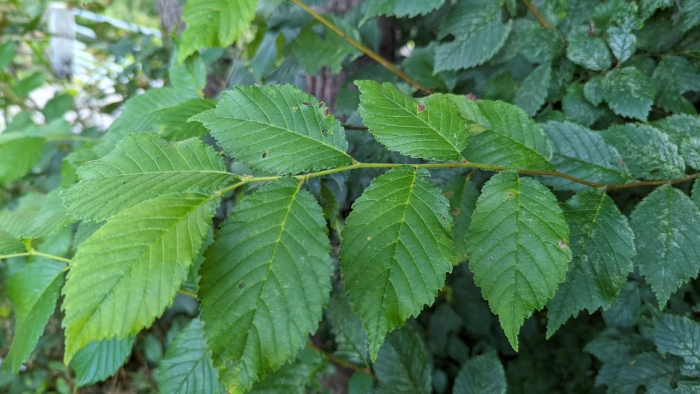Dutch Elm
(Ulmus ×hollandica)
Dutch Elm (Ulmus ×hollandica)
/
/

© Michel Langeveld
CC BY 4.0
Image By:
© Michel Langeveld
Recorded By:
Copyright:
CC BY 4.0
Copyright Notice:
Photo by: © Michel Langeveld | License Type: CC BY 4.0 | License URL: http://creativecommons.org/licenses/by/4.0/ | Uploader: rudolphous | Publisher: iNaturalist |
























Estimated Native Range
Summary
Ulmus ×hollandica, commonly known as Dutch elm, is a natural hybrid between Wych elm (U. glabra) and field elm (U. minor). It is a large deciduous tree that can reach up to 164 feet in height with a substantial trunk diameter of up to 8 feet. The Dutch elm is native to a variety of habitats across Europe, including floodplains, forest margins, and riparian zones. It is characterized by a broad crown and a bark that is grey-brown, deeply furrowed, and with a distinctive corky texture. The leaves are dark green and turn yellow in the fall. The small, inconspicuous flowers appear before the leaves in early spring and are followed by winged seeds.
The Dutch elm is valued for its rapid growth and tolerance of urban pollution, making it a popular choice for street and avenue plantings. It is also used as a shade tree in parks and large gardens. The tree prefers full sun to part shade, and it adapts well to a variety of soil types, provided they are well-drained. While some cultivars have shown moderate resistance to Dutch elm disease, this disease remains a significant threat, and preventive measures are essential to maintain the health of these trees. The ’Magdalen College’ cultivar, known for its large size and resistance to Dutch elm disease, is a notable example of a successful hybrid.CC BY-SA 4.0
The Dutch elm is valued for its rapid growth and tolerance of urban pollution, making it a popular choice for street and avenue plantings. It is also used as a shade tree in parks and large gardens. The tree prefers full sun to part shade, and it adapts well to a variety of soil types, provided they are well-drained. While some cultivars have shown moderate resistance to Dutch elm disease, this disease remains a significant threat, and preventive measures are essential to maintain the health of these trees. The ’Magdalen College’ cultivar, known for its large size and resistance to Dutch elm disease, is a notable example of a successful hybrid.CC BY-SA 4.0
Plant Description
- Plant Type: Tree
- Height: 60-120 feet
- Width: 40-60 feet
- Growth Rate: Rapid
- Flower Color: N/A
- Flowering Season: Spring
- Leaf Retention: Deciduous
Growth Requirements
- Sun: Full Sun, Part Shade
- Water: Medium
- Drainage: Medium, Fast
Common Uses
Natural Habitat
Native to a variety of habitats across Europe, including floodplains, forest margins, and riparian zones
Other Names
Common Names: Holland Elm
Scientific Names: , Ulmus ×hollandica, Ulmus campestris f. major, Ulmus campestris f. sarniensis, Ulmus campestris f. wendworthii, Ulmus campestris subsp. fungosa, Ulmus campestris subsp. major, Ulmus campestris subsp. wentworthiensis, Ulmus campestris var. dumontii, Ulmus campestris var. klemmeri
GBIF Accepted Name: